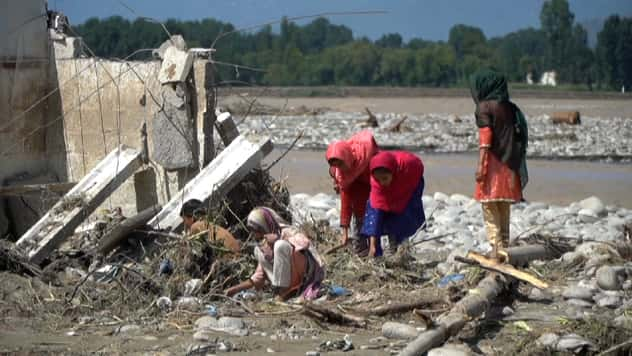akistan’s prime minister gave an update on the ongoing crisis Tuesday, which has left more than 1,100 dead, and said that at least $10 billion would be needed to provide relief and rebuild damaged infrastructure.
By Renee Duff, AccuWeather meteorologist
Published Aug. 29, 2022 12:57 PM EDT | Updated Aug. 30, 2022 11:46 AM EDT
Pakistan is in the midst of a humanitarian disaster after extreme flooding prompted by "monster monsoon" rain this summer has led to a staggering number of casualties and damage, as well as stunning building collapses throughout the country.
The flooding, which has affected more than 33 million or roughly 15% of Pakistan's population, has claimed the lives of at least 1,136 people and damaged countless homes since June, AFP reported, citing government officials who said the death toll continued rising on Monday.
In a press briefing on Tuesday, Pakistan Prime Minister Shehbaz Sharif called the floods "the worst in the history of Pakistan," according to AFP. "The damage to our infrastructure is vast and is spread all over Pakistan," Sharif said.
Sherry Rehman, the country's climate change minister, said in an interview on Twitter that Pakistan is facing "a serious climate catastrophe, one of the hardest in the decade" following exceptionally heavy rain during what she described as a "monster monsoon."
"Many districts are beginning to look like they're part of the ocean," Rehman said.
The economic losses from the flooding could reach at least $10 billion, Pakistan Planning Minister Ahsan Iqbal told Reuters on Monday. That figure was confirmed by Sharif on Tuesday who said the funds would be needed to repair infrastructure and provide aid.
Aerial footage showed muddy floodwaters covering the ground as far as the eye could see in the province of Balochistan, which has made it difficult for helicopter crews to land and drop essential rations.
On Sunday, planes carrying aid from Turkey and the United Arab Emirates safely landed in Islamabad, according to The AP. The planes were filled with tents, food and other necessary items for flood victims.
Rivers throughout the region have burst their banks amid the months-long deluge, leading to the destruction of nearby properties and farmland. Along the Swat River, shocking video footage captured the moment a large luxury hotel crumbled into raging floodwaters.
Homes are surrounded by floodwaters in Sohbat Pur city, a district of Pakistan's southwestern Baluchistan province, Tuesday, Aug. 30, 2022. Disaster officials say nearly a half million people in Pakistan are crowded into camps after losing their homes in widespread flooding caused by unprecedented monsoon rains in recent weeks.
In May, infrastructure collapsed amid a different kind of flooding. Weeks of intense heat rapidly melted a glacier in the northern part of the country, sending a torrent of water downstream and causing the destruction of the Hassanabad Bridge.
A situation report from the United Nations stated that nearly 800,000 livestock, a vital food and livelihood source for Pakistanis, have perished amid the monsoon floods. Around 2 million acres of crops and orchards have also been impacted.
Rescue and recovery operations have been hampered by the sheer number of bridges and roads that have been affected by flooding and landslides. As of Monday, more than 150 ground transportation routes have been washed away, The AP reported.
Pakistani authorities fear it will take years to recover, stating that this year's weather disaster is worse than in 2010 when monsoon floods left 1,700 people dead.
AccuWeather Lead International Forecaster Jason Nicholls has been tracking the monsoon rain reports all summer and said this monsoon season has been unusually wet, but not unprecedented for the region.
"Much of central and northern Pakistan has had 200-600% of normal rainfall with over 1,000% of normal rainfall in southern Pakistan," Nicholls said, adding that wet weather is common in a La Niña pattern. "Karachi, Pakistan, had 1,397% of normal rainfall in July, or 9.78 inches (248 mm) of rain versus a normal rainfall of 0.70 of an inch (18 mm). For the season, rainfall has been 1,001% of normal in Karachi."
Pakistan's largest city more than tripled its monthly rainfall in 24 hours during monsoon downpours in late July.
Nicholls stated that the short-term weather pattern will be a much drier one compared to recent weeks in Pakistan. However, he added that the country is not out of the woods regarding flooding threats. The monsoon season still has several weeks to go, and wet weather can return during the middle and latter stages of September.
More to read:
Want next-level safety, ad-free? Unlock advanced, hyperlocal severe weather alerts when you subscribe to Premium+ on the AccuWeather app. AccuWeather Alerts™ are prompted by our expert meteorologists who monitor and analyze dangerous weather risks 24/7 to keep you and your family safer.






No comments:
Post a Comment